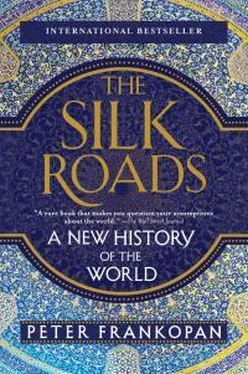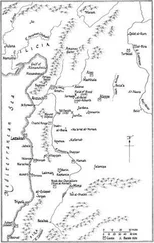Around the first century AD, the spread of Buddhism from northern India along the trade routes taken by merchants, monks and travellers accelerated rapidly. To the south, in the Deccan plateau, scores of cave temples were built, with stupas dotting the landscape deep into the Indian subcontinent.12 To the north and east, Buddhism was transmitted with growing energy by the Sogdian merchants who played a vital role in linking China with the Indus valley. These were travelling merchants from the heart of Central Asia, classic middlemen whose own close-knit networks and efficient use of credit left them ideally positioned to dominate long-distance trade.13
The key to their commercial success was a dependable chain of stopping points. As more Sogdians became Buddhist, stupas were built alongside their principal routes, as can be seen in the Hunza valley of northern Pakistan: scores of passing Sogdians carved their names into rocks alongside images of the Buddha in hope that their long journeys would be fruitful and safe—poignant reminders of the traveller’s need for spiritual comfort when far from home.14
It was not just small-scale scratchings that testify to the energetic spread of Buddhism in this period. Kabul was ringed with forty monasteries, including one that a later visitor described with awe. Its beauty was comparable to that of springtime, he wrote. “The pavement was made of onyx, the walls of pure marble; the door was made from moulded gold, while the floor was solid silver; stars were represented everywhere one looked…in the hallway, there was a golden idol as beautiful as the moon, seated on a magnificent bejewelled throne.”15
Soon Buddhist ideas and practices were spreading east through the Pamir mountains and into China. By the start of the fourth century AD, there were sacred Buddhist sites all over Xinjiang province in north-western China—such as the spectacular complex of caves at Qyzyl in the Tarim basin that included halls for worship, places dedicated to meditation and extensive living quarters. Before long, western China was studded with places that were transformed into sacred spaces, at Kashgar, Kucha and Turfan for example.16 By the 460s, Buddhist thought, practices, art and imagery had become part of the mainstream in China, robustly competing with traditional Confucianism, a broad cosmology that was as much about personal ethics as about spiritual beliefs, but which had deep roots going back a millennium. This was helped by aggressive promotion from a new ruling dynasty who, as conquerors originally from the steppes, were outsiders. As with the Kushan before them, the Northern Wei had much to gain by promoting the new at the expense of the old, and championing concepts that underlined their legitimacy. Huge statues of the Buddha were erected at Pincheng and Luoyang, far into the east of the country, together with lavishly endowed monasteries and shrines. There was no mistaking the message: the Northern Wei had triumphed and they had done so because they were part of a divine cycle, not merely brute victors on the battlefield.17
Buddhism made sizeable inroads along the principal trading arteries to the west too. Clusters of caves dotted around the Persian Gulf, as well as large numbers of finds around Merv in modern Turkmenistan, and series of inscriptions deep inside Persia, attest to Buddhism’s ability to start competing with local beliefs.18 The rash of Buddhist loan-words in Parthian also bears witness to the intensification of the exchange of ideas in this period.19
* * *
The difference, however, was that the deepening of commercial exchange galvanised Persia in another direction as it experienced a renaissance that swept through the economy, politics and culture. As a distinctively Persian identity reasserted itself, Buddhists found themselves being persecuted rather than emulated. The ferocity of the attacks led to the shrines in the Gulf being abandoned, and the stupas that had presumably been set up along the land routes within Persian territory being destroyed.20
Religions rose and fell as they spread across Eurasia, fighting each other for audiences, loyalty and moral authority. Communication with the divine was more than a matter of seeking intervention in daily life: it became a matter of salvation or damnation. The jostling became violent. The first four centuries of the first millennium, which saw Christianity explode from a small base in Palestine to sweep through the Mediterranean and across Asia, were a maelstrom of faith wars.
The decisive moment came with the seizure of power by the Sasanian dynasty, who overthrew the ruling regime in Persia by fomenting revolt, murdering rivals and exploiting the confusion that followed military setbacks on the frontier with Rome—above all in the Caucasus.21 After taking power in 224 AD, Ardashīr I and his successors embarked on the full-scale transformation of the state. It involved the assertion of a strident identity that drew a line under recent history and sought to accentuate links with the great Persian Empire of antiquity.22
This was achieved by fusing the contemporary physical and symbolic landscape with that of the past. Key sites in ancient Iran, such as Persepolis, a capital of the Achaemenid Empire, and the necropolis Naksh-i Rustām, associated with the great Persian kings like Darius and Cyrus, were appropriated for cultural propaganda; new inscriptions, monumental architecture and rock relief carvings were added which sought to elide the present regime with glorious memories of the past.23 The coinage was overhauled: the Greek script and busts styled on Alexander the Great that had been in use for centuries were replaced by a new and distinctive royal profile on one side—facing the opposite direction—and a fire altar on the other.24 The latter was deliberately provocative, a statement of intent about a new identity and a new attitude to religion. So far as the limited source material for the period allows us to understand, rulers of this region had for centuries shown tolerance on matters of faith, allowing a considerable degree of coexistence.25
The rise of a new dynasty soon brought about a stiffening of attitudes, and the teachings of Zardusht (or Zarathushtra) were unambiguously promoted at the expense of other ideas. Known to the ancient Greeks as Zoroaster—the great Persian prophet who lived around 1000 BC if not earlier still—he taught that the universe was divided according to two principles, Ahura Mazda (Illuminating Wisdom) and its antithesis, Angra Mainyu (Hostile Spirit), which were in a constant state of conflict. It was important, therefore, to worship the former, which was responsible for good order. The division of the world into beneficent and malevolent forces extended into every aspect of life and even affected areas such as the categorisation of animals.26 Ritual purification was a vital element of Zoroastrian worship, above all through fire. Ahura Mazda, as the creed set out, could bring “goodness from evil, light from darkness” and salvation from demons.27
This cosmology allowed the Sasanian rulers the opportunity to link their power with that of the golden days of ancient Persia when the great kings professed their devotion to Ahura Mazda.28 But it also provided a powerful moral framework for a period of military and economic expansion: the emphasis on constant struggle strengthened minds for battle, while the focus on order and discipline underscored administrative reforms that became the signature of an increasingly strident, resurgent state. Zoroastrianism had a robust set of beliefs that were entirely in line with a militaristic culture of imperial renewal.29
The Sasanians expanded aggressively under Ardashīr I and his son Shāpūr I, bringing oasis towns, communication routes and whole regions under direct control, or forcing them into client status. Important towns such as Sistan, Merv and Balkh were taken in a series of campaigns that began in the 220s, while a significant part of the Kushan territories became vassal states, administered by Sasanian officials who took the title kushānshāh (ruler of the Kushans).30 A triumphant inscription at Naksh-i Rustām sets out the scale of the achievement, noting how Shāpūr’s realm had extended deep into the east, running as far as Peshawar and “up to the boundaries” of Kashgar and Tashkent.31
Читать дальше











